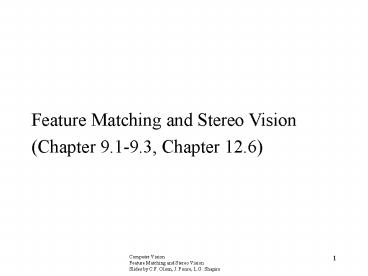Computer Vision - PowerPoint PPT Presentation
1 / 15
Title:
Computer Vision
Description:
Feature Matching and Stereo Vision. Slides by C.F. Olson, J. Ponce, L.G. Shapiro. 1 ... Stereo Reconstruction ... Stereo Disparity. left image. right image. 3D point ... – PowerPoint PPT presentation
Number of Views:30
Avg rating:3.0/5.0
Title: Computer Vision
1
Feature Matching and Stereo Vision (Chapter
9.1-9.3, Chapter 12.6)
2
Shape from single images
- There are many image cues from which we can
determine the shape of objects in the scene. - What can we determine from a single image?
3
Shape from X
- Methods for extracting shape in computer vision
include - Silhouette
- Shading
- Texture
- Focus
- Structured lighting
- Motion
- Stereo
4
Stereo Vision
- Stereo vision is the ability to infer the 3D
structure of a scene using two (or more) images
from different viewpoints - Two fundamental problems
- Correspondence problem
- Which points are the projection of the same scene
element? - Reconstruction problem
- Given a correspondence (and the camera geometry)
what is the 3D location of the observed object? - For precise measurements, calibration is
necessary.
5
Epipolar Geometry
- Epipolar Plane
- Baseline
- Epipolar Lines
- Epipoles
6
Epipolar Constraint
- Potential matches for p have to lie on the
corresponding - epipolar line l.
- Potential matches for p have to lie on the
corresponding - epipolar line l.
7
Stereo Reconstruction
If we know the corresponding points in the two
images, we can determine where the point is
relative to the cameras.
This assumes that we know precisely where the
cameras are relative to each other!
8
Binocular Fusion
Usually, we dont know in advance which points
correspond to each other.
If we get the correspondence wrong, then we will
compute the wrong point.
Finding the correspondences is an important
problem.
9
Reconstruction
If our correspondences are precisely correct,
then the rays from image points through the
optical centers will intersect. In practice,
this is rare. Solution find the point that
minimizes the distance to the two rays.
10
Rectification
A useful trick If we reproject the images
carefully (onto a common plane parallel to the
baseline) then the epipolar lines are horizontal.
We will assume that this has been done.
11
Rectification Example
Input left image Not rectified
Input right image Not rectified
After rectification
The red lines show corresponding scanlines.
12
Stereo Disparity
3D point
left image
right image
Disparity the difference in image location of
the same 3D point when projected under
perspective to two different cameras.
d xleft - xright
13
Correspondence
- How do we determine correspondences between
(rectified) images? - Usually by comparing small image patches.
?
Right image
Left image
14
Correspondence
- Far away points move little and look similar.
- Nearby points move a lot and look dissimilar.
- (Assumes rectified images.)
15
Dense Stereo
- Dense stereo information can be computed by
asking for each pixel in the left image what is
the corresponding pixel in the right image?
Left image
Color-coded range map
Right image
Range map after pruning likely mismatches































